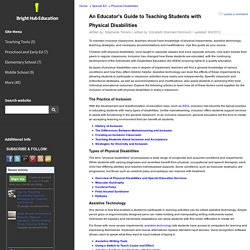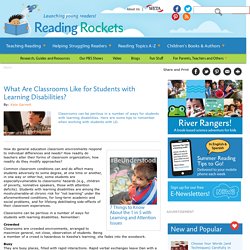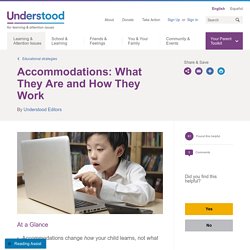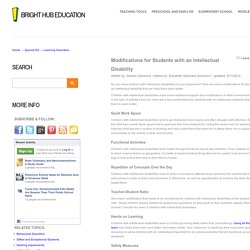

A Guide to Inclusion & Teaching Students with Physical Disabilities. Written by: Stephanie Torreno • edited by: Elizabeth Stannard Gromisch • updated: 6/6/2012 To maintain inclusive classrooms, teachers should have knowledge of physical impairments, assistive technology, teaching strategies, and necessary accommodations and modifications.

Use this guide as your source. Children with physical disabilities, once taught in separate classes and even separate schools, now learn beside their peers in regular classrooms. Inclusion has changed how these students are educated, with the continuing development of the Individuals with Disabilities Education Act (IDEA) ensuring rights to a quality education.As types of physical disabilities vary in degree of impairment, teachers will find a general knowledge of various conditions and how they affect children helpful. Assistive technology can level the effects of these impairments by allowing students to participate in classroom activities more easily and independently. References Author's own experience. What Are Classrooms Like for Students with Learning Disabilities? How do general education classroom environments respond to individual differences and needs?

How readily do teachers alter their forms of classroom organization; how readily do they modify approaches? Common classroom conditions can and do affect many students adversely-to some degree, at one time or another, in one way or other-but, some students are especiallyvulnerable to classrooms' hazards (e.g., children of poverty, nonnative speakers, those with attention deficits). Students with learning disabilities are among the mostvulnerable-at chronic risk for "not learning" under the aforementioned conditions, for long-term academic and social problems, and for lifelong debilitating side-effects of their classroom experiences.
Accommodations: What They Are and How They Work. Accommodations are changes that make it easier for your child to learn.

They don’t change what your child is learning. They change how your child is learning. It’s a way to make sure your child’s learning and attention issues don’t get in the way of showing what he knows. What Accommodations Are For Kids with learning and attention issues may need to learn material differently than other kids their age. For example, if your child has trouble with writing, the teacher might let him give answers to a test verbally. Accommodations don’t lower the expectations for what kids learn. IEP and Special Education Terms. If your child has an Individualized Education Program (IEP) or a 504 plan to address learning or attention issues, you may be considering modifications.

Modifications change what or how much a child is taught. The goal is to gear the curriculum to the child’s capability. Here’s what you need to know about modifications. IEP - Standards for Development of Program Planning and Implementation- Ontario. IEP Guide - Ontario. Individual Program Planning (Includes planning resources) - Alberta. Identifying Student Needs, Selecting Accommodations and Strategies - Alberta. Making Goals Meaningful, Measurable and Manageable - Alberta. Easy Accommodations in the General Education Classroom. This post is by special request from one of our readers!

You are always welcome to click the "Contact Us" tab at the top to request topics you'd like to read about! I was an inclusion teacher for 3 years and I learned a lot about special education before I actually went back to grad school to become a special ed teacher myself. Years later, I now have the perspective of both a general education teacher (and what is reasonable in a class of 25+ kids) and a special education teacher who wants what's best for her kids. Accommodations for children who are visually impaired. Leer este artículo en español.

English Language Learners (ELL) Accommodation Tool Kit for Culture in the Classroom. Meeting Physical Needs. Accommodations and Modifications for Children with Autism. Accommodations Which May Assist the ADHD Child. Open PDF Version Accommodations come in three distinct categories; instructional, environmental, and assessment.

The following lists are examples of interventions that may impact the success of the ADHD student. In planning a program, remember to try and catch the student doing well or behaving well. Ignore minor inappropriate behaviours. Remember, behaviour is the result of a need not being met. Modifications for students with Intellectual Disability. Written by: Sharon Dominica • edited by: Elizabeth Stannard Gromisch • updated: 9/11/2012.

Cystic Fibrosis: Physical Activity and Exercise. What is cystic fibrosis?

Cystic fibrosis (CF) is a genetic disease. It affects mainly the lungs and digestive tract. CF causes a build-up of thick mucus in the lungs, which leads to breathing troubles. Mucus in the lungs also benefits bacteria that are responsible for infections. A child with CF may have cycles of infection. Thick mucus also blocks the ducts of the pancreas. Why exercise is important in CF treatment Exercise benefits us all, but people with CF benefit even more from being physically active because exercise can: slow the rate of decline in lung function, which means children with CF may keep good lung function longer. If you have CF, being physically active will not just make you feel better, it will improve your quality of life. How to get the most out of exercise. Sensory Activities for Children with Autism. Strategies for Children with Neglect and Attachment Issues.